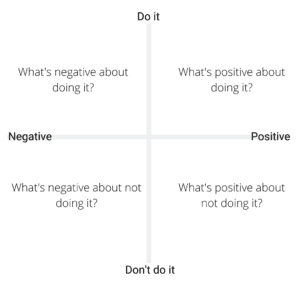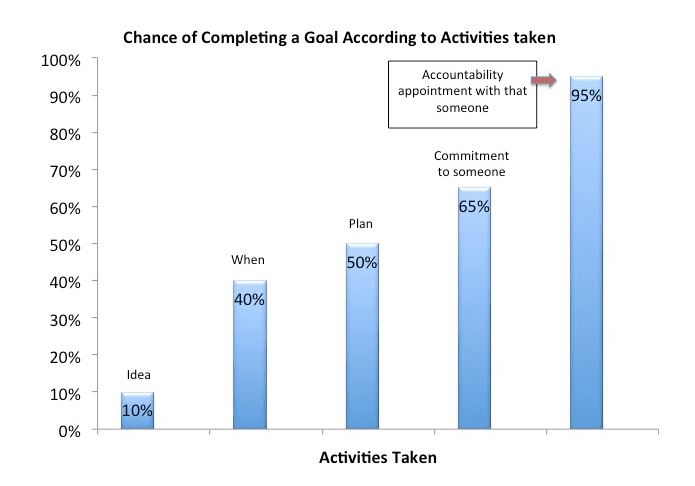“The universe doesn’t give you what you ask for with your thoughts; it gives you what you demand from your actions” Dr Steve Maraboli
So you’ve used this time productively and done what everyone recommended and:
- Reflected on life before lockdown and where you are now
- Identified what works and what doesn’t
- Defined some ideas about what you would like to do next
But how do you turn these ideas into actions that yield results?
Many of us believe that being productive is taking action and at some level this is true as it is the actions that drive the results. However, in our haste to take action many of us fail to strategise and plan adequately and spend a lot of time taking the wrong actions! This often leads us to give up on our ideas as we may assume it is the idea that is wrong rather than the actions.
Taking time to identify the right actions optimises the likelihood of success.
As you go through this process be aware of your usual patterns:
- Do you usually overthink or over analyse?
- Do you have a habit of procrastinating?
- Do you fear failure or criticism?
- Do you find it hard to put yourself first?
Notice your patterns and put in strategies to ensure they don’t hold you back. For example:
- If you overthink, use your emotions to guide you – what does your gut instinct tell you?
- If you procrastinate, ensure you stick to deadlines
- If you fear failure, reframe failure as feedback and use the insights to inform next steps
- Involve someone with a different style to challenge and support you
Here is a summary of the phases that take you from an idea to action:
PHASE 1 THE IDEA
1 ARTICULATE
Stephen Covey in ‘The 7 habits of Highly Effective People’ says: “To begin with the end in mind means to start with a clear understanding of your destination. It means to know where you are going, so that you better understand where you are now and so that the steps you take are always in the right direction.”
Adopt a mindset of non-judgement and articulate your idea as if there were no constraints. Many of us stop ourselves pursuing ideas because we might feel we don’t deserve it, we’re not good enough or that we don’t have time or the resources.
For a moment, choose to put those beliefs to one side and let your idea unfold as if there were no constraints and ANYTHING IS POSSIBLE
Ask yourself:
- What do I want to achieve?
- What does success look & feel like? How will I know that I have achieved my goal?
- When do I want to have achieved it by?
Articulate your idea in as much specific detail as possible.
2 TEST
Once you have articulated your idea it is important to test it before taking it any further.
Ask yourself:
- For what purpose do I want this?
- What is important about achieving this goal? What difference will it make?
- Is it what I WANT or what I feel I SHOULD do?
- Is it for someone else?
- How will this goal impact other areas of my life?
- If I could have this right now would I take it?
Use the Cartesian model to see your idea from every angle and challenge your thinking.
Consider the pros and cons of pursuing and succeeding with your idea, DOING IT, and not pursuing and succeeding, NOT DOING IT. Answer each question intuitively, and complete each box of the grid.
Having completed the grid, how do you feel about your idea? Name the emotion and consider what it is telling you.
- Do you still want to do it?
- What’s missing?
- Do you need to adjust it at all?
3 VISUALISE
Visualizing your ideas is one of the most powerful things you can do as it:
- Activates the creative powers of your subconscious mind
- Focuses your brain to notice and seek out available opportunities and resources
- Magnetizes and attracts you to the right people, resources and opportunities
- Activates emotions that will drive you forward for example, excitement, interest, joy provide energy to move you towards something
Take the time to manifest the vision in whatever format works for you. Popular ideas include a vision board, mindmap, screensaver, story, photograph etc
Put it somewhere in clear view that you can see regularly (fridge or computer work well) to keep you focussed and nudging you into action.
PHASE 2 THE STRATEGY AND ACTION PLAN
Now you have tested your idea and created a visual for it, you are ready to create a strategy:
1 PROGRESS TO DATE
This helps you take credit for any progress you have already made, providing some motivation and positivity to continue. It also helps you take stock of anything that may have impacted your progress to date.
Ask yourself:
- What have I achieved so far?
- What has stopped me from doing more?
- What challenges do I face?
- What resources (time, skills, personal qualities, money, support etc) do I have already that may help?
- Who can support me? Brainstorm everyone in your network – family, friends, work colleagues etc
- What extra resources do I need?
2 BRAINSTORM POSSIBLE ACTIONS
This should be everything that you COULD do (identify all options, often the wildest ideas have an element of inspiration). As in phase 1 above, don’t judge the actions and remove any perceived constraints:
- What if you couldn’t fail?
- What if money, time and skills were not an issue?
- What if anything was possible?
Consider:
- Resources available – people, support, money, equipment etc
- Previous successes
- What others have done
- What you might advise someone else to do in the same situation
Ask yourself:
- What could you do that would move you one step closer?
- What have you done before in similar situations?
- Who do you know that has done this? What did they do? How can you model them?
- What advice would you give a friend that wanted to do this?
PHASE 3 THE COMMITMENT TO ACTION
The Institute of Applied Emotional Intelligence (Wiseman 2004) carried out research into the chance (%) of completing goals in relation to the actions taken toward them with the following results:
Our brains like familiarity and resist change, preferring to remain in our comfort zones. These steps support you through change, to establish new habits and do something different.
1 COMMIT
Review the list of possible actions in phase 2 and decide on the specific actions you will commit to.
2 PLAN
Create a detailed action plan including:
- One off actions
- Habits that will deliver success
- Tweaking of old habits that might sabotage your success
3 SCHEDULE
Decide when you will take each action
4 COMMIT TO SOMEONE YOU RESPECT
Tell someone about what you are doing and commit to updating them on your progress. This feeds on our fear of failure or of being judged or criticised – use your fears and motivations to fuel your actions.
5 MEASURE
Decide what you will measure and how “What gets measured gets focussed on”
Note: There is often a time lag before results are realised so measure the actions that will deliver success rather than the expected outcomes. This is particularly important in the early stages to avoid getting demotivated.
6 CELEBRATE your progress and successes
7 MONITOR PROGRESS
Reflect on progress on a regular basis, decide on what’s working and what isn’t and reset your strategy and plan as appropriate
AND NOW:
TAKE THE FIRST STEP & SCHEDULE THE NEXT STEP UNTIL TAKING ACTION BECOMES A HABIT
Remember success can only be achieved through good execution of an idea. Learn, think, strategise and plan then TAKE ACTION.


